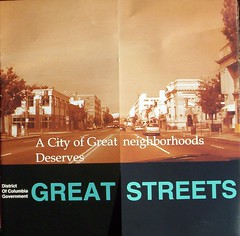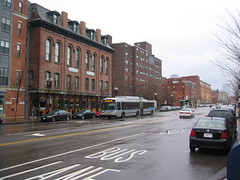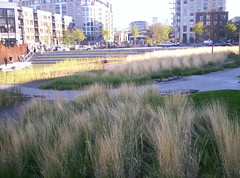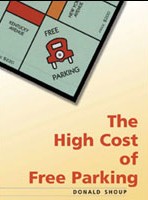DC Great Streets conference today
Updated -- the conference is today. (Post from Tuesday Jan. 10).
At least try to make the evening presentations, from 6:00 pm to 8:30 pm on -- Retail Streets - Kiku Obata; The High Cost of Parking - Donald Shoup, UC-Berkeley; Green Streets - Margie Ruddick, WRT; and Room to Move - Jeff Tumlin, Nelson Nygaard.
________________________
 Great Streets program brochure.
Great Streets program brochure.From Karina Ricks, Great Streets Project Coordinator, DDOT:
The District Department of Transportation, in partnership with the DC Economic Partnership, has requested the services of ULI: The Urban Land Institute, in assembling a National Blue Ribbon Panel to provide review of and expert recommendations for the Great Streets Transportation Framework Plan. This body of nationally recognized experts will spend a week in Washington DC to share their knowledge and experience in creating great, sustainable streets, superb public spaces, and thriving retail corridors.
I invite and encourage you to attend a day of technical case studies outlining the experience of other successful corridors across the nation and an evening of innovative approaches to design on Wednesday, January 18 in the Columbus Room of Union Station. Consult our website for the latest information.
 Washington Street, Boston. Silver Line Bus Rapid Transit bus in the background. Photo by Steve Pinkus.
Washington Street, Boston. Silver Line Bus Rapid Transit bus in the background. Photo by Steve Pinkus.10:00 AM Charge to Panel, Mayor Anthony A. Williams
10:30-3:30 PM National Case Studies and Lessons Learned
-- 10:30-11:30 Washington Street, Boston MA
-- 11:45-12:45 Indiana Avenue, Indianapolis IN
1:00-1:45 Lunch Break
2:00-3:30 PM National Case Studies and Lessons Learned (continued)
--2:00-3:00 Pearl District, Portland OR
--3:15-4:15 High Street, Columbus OH
6:00-8:30 PM Innovative Ideas for Great Streets, Moderator - Robert Bobb, City Admin.
-- Retail Streets - Kiku Obata
-- High Cost of Parking - Donald Shoup, UC-Berkeley
-- Green Streets - Margie Ruddick, WRT
-- Room to Move - Jeff Tumlin, Nelson Nygaard
 Park in the Pearl District, Portland, Oregon. This park was constructed as part of the community benefits plan for the development of this neighborhood on the freight railyard.
Park in the Pearl District, Portland, Oregon. This park was constructed as part of the community benefits plan for the development of this neighborhood on the freight railyard.Great Streets Symposium Blue Ribbon Panel
Michael Banner, Los Angeles LDC, Inc. (Chair). Michael Banner is President and CEO of the LosAngeles LDC, Inc. (LDC), a nonprofit community development financial institution that provides innovative financial advisory services to achieve the target investment goals of its private and public sector clients. The LDC has an extensive track record of improving the flow of capital into community and economic activities in emerging markets and in under-served communities. He is a ULI Inner City Advisor and has extensive background in commercial banking and real estate finance.
Greg Baldwin, Zimmer Gunsul Frasca Partnership - Portland, OR. Much of Greg Baldwin's career has been influenced by his commitment to integrate urban design and architecture through cooperative public and private partnerships. Several of his projects, perhaps most notably Portland's MAX Light Rail, have become models for other cities nationally. He has designed complex building projects across the country-- office and mixed-use developments, historic and adaptive reuse, academic and performance facilities, and transit systems-- with clients aggressive in their efforts to enhance the livability of their communities.
 The Boulevard Book: History, Evolution, Design of Multiway Boulevards by Allan B. Jacobs, Elizabeth Macdonald and Yodan Rofé. First built in Europe and grandly imported to the United States in the mid-nineteenth century, the classic multiway boulevard has been in decline for many years, victim of a narrowly focused approach to street design that views unencumbered vehicular traffic flow as the highest priority. The American preoccupation with destination and speed has made multiway boulevards increasingly rare as artifacts of the urban landscape. This book reintroduces the boulevard, tree-lined and with separate realms for through traffic and for slow-paced vehicular-pedestrian movement, as an important and often crucial feature of both historic and contemporary cities.
The Boulevard Book: History, Evolution, Design of Multiway Boulevards by Allan B. Jacobs, Elizabeth Macdonald and Yodan Rofé. First built in Europe and grandly imported to the United States in the mid-nineteenth century, the classic multiway boulevard has been in decline for many years, victim of a narrowly focused approach to street design that views unencumbered vehicular traffic flow as the highest priority. The American preoccupation with destination and speed has made multiway boulevards increasingly rare as artifacts of the urban landscape. This book reintroduces the boulevard, tree-lined and with separate realms for through traffic and for slow-paced vehicular-pedestrian movement, as an important and often crucial feature of both historic and contemporary cities.Allan Jacobs, University of California Berkeley. Allan Jacobs has observed and measured scores of famous urban streets and boulevards, in order to explore what makes great public streets. A professor at the University of California at Berkeley, Jacobs keenly observes and researches successful design of public places -streets, spaces, and parks. Prior to his tenure at Berkeley, Jacobs served as Director of Planning for the City of San Francisco from 1967-1975. As Director of Planning, Jacobs developed a new comprehensive plan for the city, emphasizing public access to the San Francisco waterfront, design guidelines for downtown development, and revitalization of neighborhood design throughout San Francisco.
Kiku Obata, Kiku Obata & Company. Kiku Obata launched her retail design firm in 1977 applying innovative design to large, multidisciplinary projects to create memorable identities and places. Kiku Obata provides design solutions that distinguish retail clients in their marketplace and help redefine their industries. Ms. Obata has worked on projects nationally and internationally in both downtown and neighborhood settings. She advises clients and communities on the interface of the public street environment and interior retail environment to maximize the customer experience and retail success.
Margie Ruddick, Wallace Roberts Todd - Philadelphia. Through nearly 20 years of practice, authorship and teaching, Margie has pioneered an approach to landscape design that blends a distinct aesthetic expression with ecological purpose. Each of her projects arises from its particular context, addressing clients' objectives hand-in-hand with a site's natural systems and its social, architectural, historical, cultural and economic frameworks. A principal of the firm, Margie works with clients to create memorable places that tread lightly on the earth
 Click here to read the first chapter of The High Cost of Free Parking.
Click here to read the first chapter of The High Cost of Free Parking.Donald Shoup, University of California - Los Angeles. With a background in economics, engineering, and planning, Donald Shoup has focused his research on public finance, transportation and the land market. He has extensively studied the issue of parking as a key link between transportation and land use, with important consequences for cities, the economy and the environment. Mr. Shoup bringstremendous experience in innovative tools for finance of neighborhood public investments.
Jeffrey Tumlin, Nelson/Nygaard - San Francisco. Tumlin is an expert in multimodal transportation planning, with an emphasis in minimizing the impacts of growth. As a Partner in Nelson/Nygaard Consulting Associates, he has been responsible for a range of projects including university and city strategic transportation plans; National Park strategic transportation plans; Transportation Management Plans for major development projects; and Transit Oriented Development plans for major urban infill projects addressing parking policies, management and impacts, bus/shuttle/rail coordination, bicycle and pedestrian circulation, and the functional and aesthetic considerations of street design. Mr. Tumlin has previously served as Director of Urban Ecology, Inc., was a Founding Board Member of the Bay Area Transportation and Land Use Coalition and Former Chair of the San Francisco Joint Open Space Committee.
Chester Chellman, TND Engineering - New Hampshire (invited). Chester E. "Rick" Chellman has more than thirty years experience in zoning, civil engineering, land surveying, engineering consulting, traffic engineering and development planning. Mr. Chellman has extensive site planning, civil and forensic engineering, and land use experience. Mr. Chellman has worked extensively on the engineering and traffic engineering aspects in connection with matters of street design, vehicular and human-powered traffic control and external transportation connections. TND Engineering is a specialty firm addressing engineering consulting and Traditional Neighborhood Development with a primary focus on street design and transportation planning, with an associated understanding of urban design.
Philip Hart, Hart Realty Advisors - Boston . (no bio provided)
Index Keywords: urban-revitalization; mobility



0 Comments:
Post a Comment
<< Home